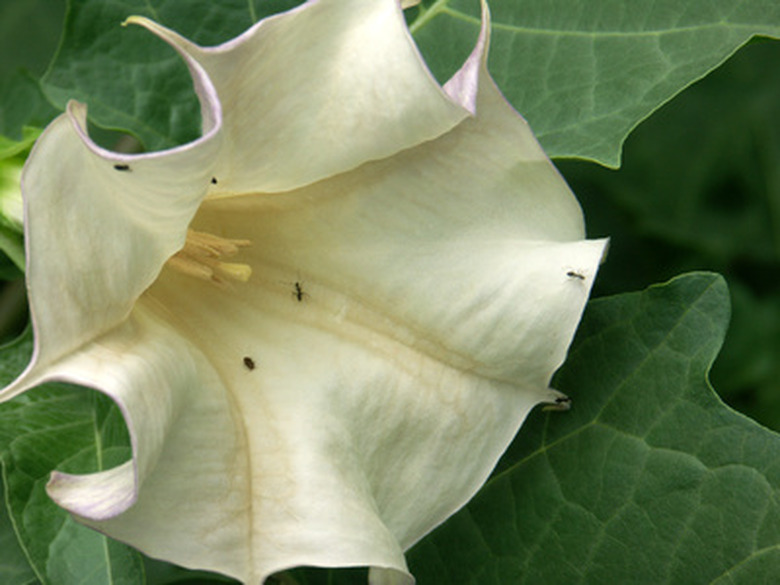Moonflower Effects
According to the Centers for Disease Control, there were more than 1,072 moonflower poisonings and one death in 2002. Datura inoxia and Ipomoea alba are both known as moonflowers because both produce large, white night-blooming blossoms. However, that is not where the similarities end.
According to the Centers for Disease Control, there were more than 1,072 moonflower poisonings and one death in 2002. Datura inoxia and Ipomoea alba are both known as moonflowers because both produce large, white night-blooming blossoms. However, that is not where the similarities end. The moonflower known as Ipomea alba is a toxic cousin of the equally toxic morning glory–or Ipomea nil.
Pulmonary
Moonflower can cause tachycardia and heart palpitations, and raise your blood pressure. In Akron, Ohio, in 2002, a young boy consumed nearly 200 moonflower seeds. The toxicity caused his blood pressure to plummet, nearly killing him, according to Jonathan Costen of Channel 5 News in Cleveland.
- According to the Centers for Disease Control, there were more than 1,072 moonflower poisonings and one death in 2002.
- The toxicity caused his blood pressure to plummet, nearly killing him, according to Jonathan Costen of Channel 5 News in Cleveland.
Mental
Long before the invention of Rohypnol, thugs used moonflower to knock out their victims, according to the Drug Safety Site. Besides causing disorientation, memory loss, agitation, confusion and panic, both moonflower varieties cause hallucinations that can lead individuals to harm themselves or others. Over the centuries, moonflower has been used by witches in Europe, Incan priests and shaman, according to the Drug Safety Site. Worse yet, moonflower ingestion can lead to coma and death.
Physical
Other physical effects of these night-blooming flowers include vomiting, diarrhea, convulsions, fever, blurred vision and headaches. According to eBasedPrevention.org, ingesting moonflower also can cause dilated pupils, urinary retention and a dry mouth. According to the CDC, signs and symptoms of moonflower poisoning can last 24 to 48 hours.
- Long before the invention of Rohypnol, thugs used moonflower to knock out their victims, according to the Drug Safety Site.
- According to eBasedPrevention.org, ingesting moonflower also can cause dilated pupils, urinary retention and a dry mouth.
Moonflower Care
Moonflowers like a well-drained and fairly rich soil. If your garden soil drains poorly or has a large amount of clay in the composition, dig in a thick layer of well-rotted compost to loosen the soil and to add drainage. The compost will also add nutrients to the soil, feeding the moonflower plants as they grow. Moonflowers do best when planted with an eye to their future growth. Avoid the sides of garages or other large structures that may shade the plants. Moonflowers can grow up to 12 feet, and need a solid support system. Stakes are probably not enough, so sow the seeds at the base of patio arbor supports, near telephone poles or around the legs of a lawn swing. Moonflowers do not need additional fertilizer during the season, as they grow best in average soil. Clip off the blooms as they wilt in the fall so they don't have a chance to spread their seeds. In U.S. Department of Agriculture plant hardiness zones 9 to 11, it will live year-round, but grows as an annual elsewhere.
- Moonflowers like a well-drained and fairly rich soil.
- Moonflowers do not need additional fertilizer during the season, as they grow best in average soil.
Moonflower Care
Moonflowers like a well-drained and fairly rich soil. If your garden soil drains poorly or has a large amount of clay in the composition, dig in a thick layer of well-rotted compost to loosen the soil and to add drainage. The compost will also add nutrients to the soil, feeding the moonflower plants as they grow. Moonflowers do best when planted with an eye to their future growth. Avoid the sides of garages or other large structures that may shade the plants. Moonflowers can grow up to 12 feet, and need a solid support system. Stakes are probably not enough, so sow the seeds at the base of patio arbor supports, near telephone poles or around the legs of a lawn swing. Moonflowers do not need additional fertilizer during the season, as they grow best in average soil. Clip off the blooms as they wilt in the fall so they don't have a chance to spread their seeds. In U.S. Department of Agriculture plant hardiness zones 9 to 11, it will live year-round, but grows as an annual elsewhere.
- Moonflowers like a well-drained and fairly rich soil.
- Moonflowers do not need additional fertilizer during the season, as they grow best in average soil.
